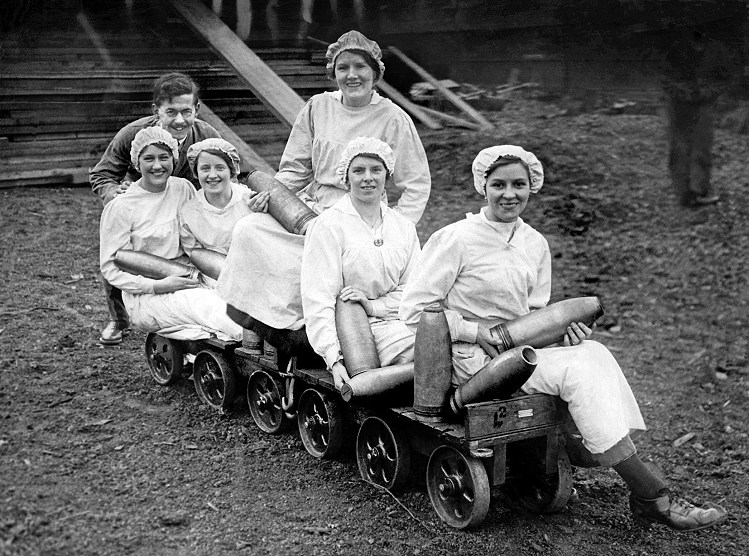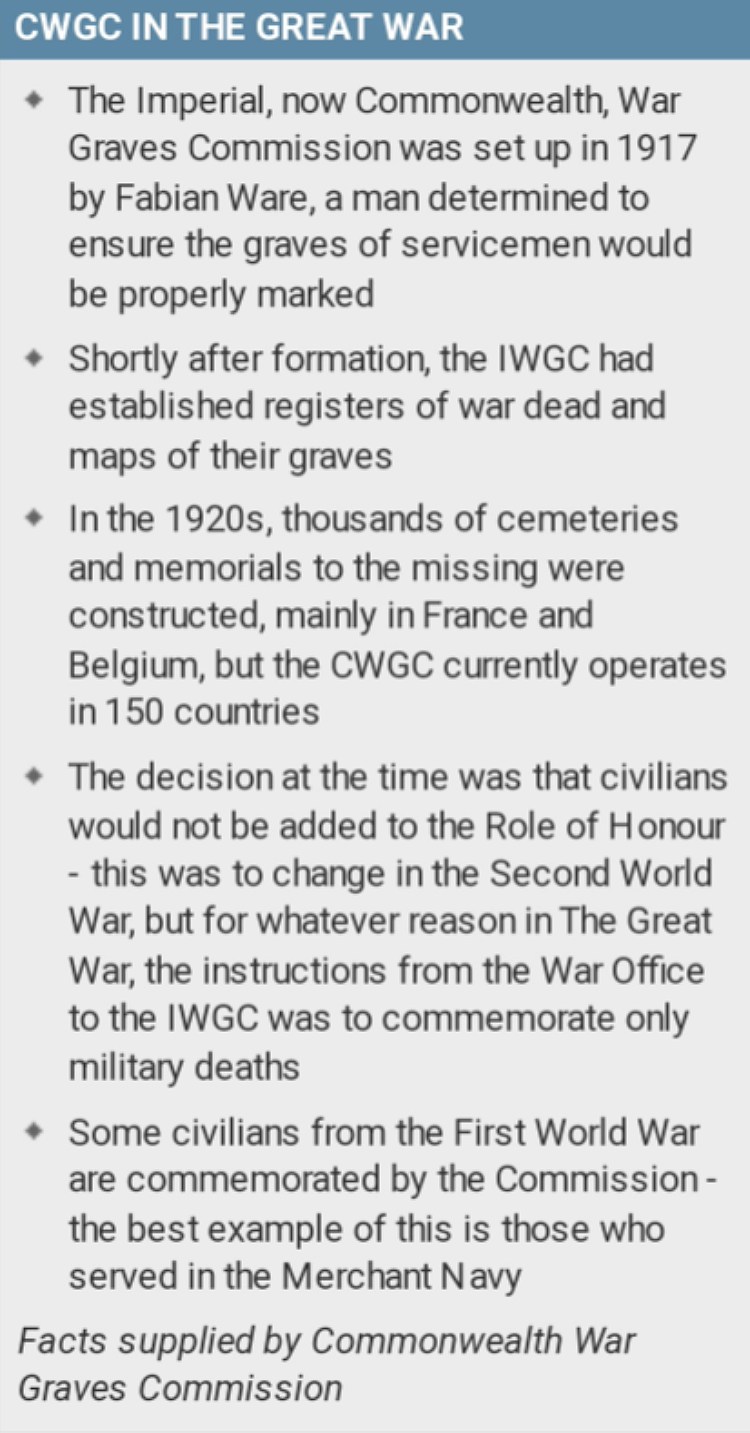Dorothy May Raven, Munitions Worker.
Dorothy May Raven was born on the 19th September 1896 in Barnsley and baptised at St Mary's Church, Barnsley on the 28th October 1896. She was the only girl and youngest of eight children born to policeman John William Raven (born 1859 in Kings Lynn, Norfolk) and his wife Emma (nee Elvin) who had married on the 18th March 1884 in Market Rasen, Lincolnshire. All eight of the Raven children were born in Barnsley, but one child Fred Raven died aged 5½ months in 1886.
By the age of 14 years Dorothy was employed as a silk spinner. During WW1 Dorothy worked in a munitions factory in Brighouse where she daily risked her life to supply the armed services with ammunition. A now fairly well known phenomenon was the TNT poisoning which turned many women's skin yellow. But the Canary Girls, as they became known, didn't just suffer with a change in skin colour. TNT poisoning also meant coughs, chest infections, digestive problems and ultimately could kill.
Dorothy's father, John William Raven had joined the police force on the 13th November 1882 and, after serving his probationary period in Wakefield, he was sent to Barnsley where he remained until 1896. He was then transferred to Eccleshill, remaining there until November 1899. From there he was transferred to the Dewsbury area and was stationed at Ossett until 1903 when he was transferred to the Halifax Division.
When he retired on New Year's Eve 1907, John William Raven had served as a police officer for 25 years. He worked as a postman after his retirement. Later he was a member of the First Reserve, and in 1914 he resumed active duty for a short time guarding waterworks at Denshaw, Saddleworth. He died on the 1st June 1937 aged 79 years.
In 1899, when her father became a policeman in Ossett, the Raven family moved from Eccleshill in Bradford to live at Ryecroft Street, Ossett when she was three years of age. In 1903, the Raven family left Ossett and moved to Brighouse, living at 7, Hardy Street, where they were living in 1911.
The war changed the way of the world rapidly on the home front and by February 1918 an estimated 1.4m British women were working in jobs that would previously have been done by men. Around half of them were working in munitions and Huddersfield had a vital role to play in making sure the soldiers had the weapons they needed at the front.

Above: Female munitions workers during WW1.
By 1918, Huddersfield was manufacturing 33% of Britain's high explosives - the majority at British Dyes at Leeds Road, which went on to become ICI. And on October 6, 1916, British Dyes came perilously close to causing Huddersfield's greatest-ever disaster.
At that time it was producing almost 5,000 18lb shells per week and as the smoke billowed skyward panic spread through the densely populated neighbourhood. Hundreds of homes were evacuated and streets were thronged as residents moved to a safer distance from what was effectively the biggest bomb Huddersfield has ever seen.
Inside the factory some employees bravely remained to fight the blaze. John McMaddocks rushed to operate the fire extinguishers before using his body as a draught excluder to prevent the flow of air from 'fanning the flames' into the explosives stores. His main assistance came from employees Ethel Brown and Private Charlie Shaw before the fire brigade arrived.
Thankfully, after several hours, and at considerable risk, they extinguished the blaze. In 1918, Mr McMaddocks, of Sheepridge; Ethel, who lived in Brighouse, and Pte Shaw of Moldgreen were awarded the MBE 'for courage and resource in dealing with a fire at an explosives factory at great personal risk.'
A now fairly well known phenomenon was the TNT poisoning which turned many women's skin yellow. But the Canary Girls, as they became known, didn't just suffer with a change in skin colour. TNT poisoning also meant coughs, chest infections, digestive problems and ultimately could kill.
Dorothy died at her home in Smithy Carr Lane, Brighouse three days before the particularly poignant date of November 11th 1918 (Armistice Day). Her death certificate (below) reveals what had caused her premature death.

22 year-old Dorothy had tragically succumbed to the flu pandemic that swept the globe during WW1, killing an estimated 50 million people worldwide. The same sickness that killed Dorothy had also killed her brother Charlie.
On the 30th May 1921, at St Martin's Church, Brighouse, the town had turned out to witness the unveiling of a memorial window and a tablet, both paid for by public subscription, to the memory of 49 men connected with the church who had been killed in WW1. Among those names were those of Charlie Raven and his brother George Frederick Raven.
There is no memorial for Dorothy May Raven. When we remember the service personnel who laid down their lives, let's not forget those whose names have been forgotten, those who remained at home and also gave their all.

There are two women named at our Memorial in Ossett, one is a civilian nurse Beatrice Milner and the other Augusta Myers who served in the W.A.A.F. There are also two civilian firefighters named: Eric W.W. Archer and Albert V. Haigh, but all from WW2.
Could Dorothy May Raven, a civilian munitions worker, who died during WW1, be the third woman to be commemorated at the Ossett War Memorial?
There is a local precedent in Annie Leonard, who worked at the Barnbow Munitions Factory, near Garforth. Annie died at the age of 22 years on the 21st July 1916. Her inquest was heard behind closed doors on the 27th July and her death was recorded as "Misadventure. Acute yellow atrophy of the liver contracted at her work at the factory at Barnbow near Garforth".
Annie is commemorated on the local Carlinghow memorial, at St John's Church. She is one of 1,400 women whose names are inscribed on the oak screens of the National Women's Memorial at York Minister. However, her name was not included on the Batley War Memorial, despite her brother Walter writing to the Town Clerk of Batley. His request was refused with a one word response "No":
"She was the only Batley girl who gave her life for her King & Country, and is on the roll of honour at Carlinghow St. John's and Carlinghow Working Men's Club, so I think it only fair to her and her folks that she should be placed amongst the Batley Roll of honour. She worked at the Barnbow Factory and was poisoned by T.N.T. poisoning. Her name ANNIE LEONARD".
That omission has now been corrected. During the First World War centenary commemorations members of Batley History Group, who had undertaken research into those named on the War Memorial, identified Annie amongst those local people not remembered. As a result of their work their names, including Annie's, were added to the Memorial in 2019.
In August 2022 the name of Dorothy's elder brother George Frederick Raven, once of Ryecroft Street, Ossett was quietly added to the Ossett War Memorial. Their brother Charlie Raven's name we expect will be added in 2023.
My thanks to Anne-Marie Fawcett for her research on the Raven family.
Further researched and written in April 2023 by Stephen Wilson for ossett.net, the first established and only Ossett history website with original, non-plagiarised and accurate content.